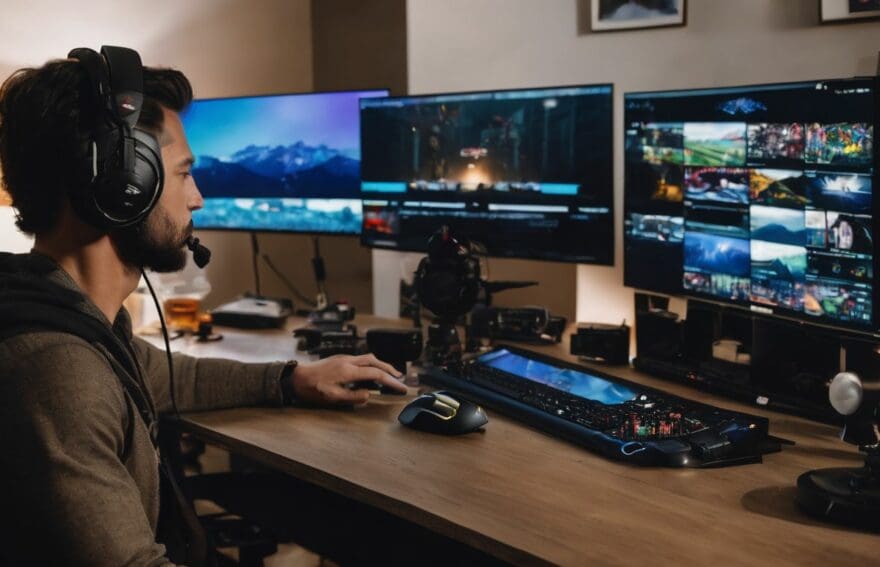The Evolution of Esports Broadcasting: From Twitch to Traditional TV

Updated On: October 24, 2025 by James Connolly
Have you ever found yourself marvelling at the meteoric rise of esports broadcasting? From its humble beginnings streaming in the background on niche corners of the internet to taking centre stage on mainstream television – it’s been quite the extraordinary transition.
We’ve kept our finger on the pulse throughout this journey, tracing its roots back to Twitch in 2011 when they began changing the game. In this piece, we’re peeling back the layers to reveal how esports has blossomed into a globally captivating extravaganza, no longer confined to just gaming enthusiasts but now commanding an audience of millions around our planet.
So settle in and join us as we explore this remarkable narrative behind your screen. Read on!
Understanding Esports Broadcasting
Esports broadcasting involves the live commentary and analysis of esports events, requiring key skills such as game knowledge, public speaking, and quick thinking. As the popularity of competitive online gaming continues to rise, educational pathways for aspiring esports broadcasters are also becoming more prevalent.
Definition and overview
Esports broadcasting brings the thrill of competitive gaming to screens worldwide, combining live commentary with on-the-spot analysis of events. Since Twitch came into play in 2011, it’s revolutionised how we connect and dive into the heart of online battles, making stars out of gamers and turning their skills into spectator sports.
Our journey through this fascinating world begins by understanding that esports streaming is much more than just showing a game being played; it’s about crafting stories, explaining strategies, and sharing the excitement with an ever-growing audience.
We’re not just viewers anymore; we’re part of a digital revolution that has shifted power from traditional television to online platforms like Twitch and YouTube. The evolution has been quick yet profound – what started as simple streaming now includes high-quality production values akin to traditional sports broadcasting.
Navigating through this landscape requires specific talents – something we’ll delve deeper into next.
Key skills needed
To effectively participate in esports broadcasting, certain key skills are essential. These skills enable broadcasters to provide engaging and informative coverage of esports events. The following are the key skills required for successful esports broadcasting:
- Proficient knowledge of different video game genres and titles, enabling insightful analysis and commentary during live broadcasts.
- Excellent communication skills to convey information clearly and engage viewers while providing real-time commentary on gameplay strategies and event highlights.
- Strong adaptability to rapidly changing game scenarios, ensuring seamless coverage and quick analysis of in-game developments.
- Technical proficiency in operating broadcasting equipment and software tools, facilitating smooth live streaming and production quality.
- Creative storytelling abilities to captivate audiences by narrating the unfolding narrative of competitive matches with enthusiasm and clarity.
- Deep understanding of the esports community, its culture, and fan base dynamics to resonate with viewers’ interests and preferences.
- Analytical skills to interpret player actions, team dynamics, and game strategies with accuracy while delivering informative insights to the audience.
Educational pathways
Esports broadcasting requires specific skills and knowledge, which can be gained through various educational pathways. Pursuing a degree in journalism, communication, or media studies can provide a strong foundation for understanding the nuances of broadcasting esports events.
Additionally, courses in video production and editing are beneficial to gain practical skills essential for creating engaging content for online streaming platforms. Moreover, aspiring broadcasters can benefit from mentorship and networking opportunities within the esports community to develop their on-camera presence and commentary skills.
For those interested in a more hands-on approach, gaining experience through internships at gaming companies, event organisations, or media outlets can provide valuable insight into the dynamics of esports broadcasting.
The Rise of Online Streaming Platforms
Online streaming platforms like Twitch, YouTube, and Mixer have completely transformed the way esports events are broadcasted. These platforms allow for real-time interaction between players and viewers, creating an immersive gaming experience unlike traditional TV broadcasts.
Twitch, YouTube, and Mixer
Esports broadcasting has significantly transformed with the rise of online streaming platforms like Twitch, YouTube, and Mixer. These platforms have revolutionised how audiences access esports events and interact with their favourite gamers. Twitch, launched in 2011, emerged as a game-changer by connecting gamers to esports competitions and influential personalities.
- Live Interaction: Viewers can actively engage with their favourite players and influencers during live streams, fostering a sense of community and enhancing the overall gaming experience.
- Diverse Content: These platforms offer a wide array of esports content, from live tournaments to behind-the-scenes insights, catering to the diverse interests of gaming enthusiasts.
- Interactive Features: Through these channels, viewers can access interactive features such as live chat and real-time audience polls, creating an immersive viewing experience that goes beyond traditional TV broadcasts.
- Audience Reach: With millions of users worldwide, these platforms have expanded the reach of esports broadcasting to a global audience, allowing passionate gamers and novice players alike to access high-quality gaming content from anywhere.
- Influencer Engagement: The platform’s interactive nature has facilitated direct engagement between gamers and their fan base, shaping the landscape of esports broadcasting by elevating individual streamers to celebrity status.
- Extensive VOD Library: Beyond live streams, these platforms host extensive libraries of video-on-demand content, providing viewers with on-demand access to past tournaments and gameplay highlights.
Impact on traditional TV
As Twitch and other online streaming platforms continue to dominate the esports broadcasting scene, traditional TV has felt the impact of this technological shift. Esports’ explosion onto the mainstream scene has required television networks to adapt and cater to this growing audience.
The significant value traditional TV holds for esports stakeholders cannot be overlooked, as it provides access to a large and diverse audience for influencers and teams alike.
TV’s ability to reach audiences who may not actively engage with online gaming technology is a crucial factor in bridging the gap between passionate gamers and novice gamers. This transition from Twitch to traditional TV demonstrates how esports has helped accelerate the shift away from conventional sports broadcasting in favor of online streaming platforms like Twitch and YouTube.
The Digital Era and Esports Viewing
With the rise of online streaming platforms like Twitch, YouTube, and Mixer, esports broadcasting has evolved to accommodate the digital era. Live streaming events with interactive features have changed the way audiences engage with and view esports content.
Live streaming of events
Esports broadcasting features live streaming of events, providing an immersive viewing experience for audiences. Esports events are broadcast in real-time, allowing viewers to witness the action as it happens and engage with the content through various interactive features.
- Viewers can watch their favourite players and teams compete in real – time, creating a sense of excitement and anticipation.
- Live chat functions enable audiences to interact with each other, share thoughts on the gameplay, and connect with fellow fans.
- Interactive polls and surveys often accompany the live stream, offering viewers opportunities to participate actively in the event.
- Multiple camera angles and perspectives are frequently available, allowing audiences to customise their viewing experience.
- Live commentary from experienced broadcasters enhances understanding of the gameplay and provides insights into strategies and techniques used by players.
Interactive features
Esports broadcasting offers a range of interactive features that enhance the viewer experience. These features include:
- Real-time chat: Viewers can engage with each other and the streamer, discussing gameplay strategies and sharing their excitement.
- Polls and voting: Streamers often use interactive polls to involve viewers in decisions such as character selection or game mode.
- Live Q&A sessions: Esports broadcasters frequently interact with their audience by answering questions and providing insights during live streams.
- Viewer participation events: Some broadcasts incorporate interactive elements that allow viewers to affect the outcome of a match or event.
Challenges and Opportunities in Esports Broadcasting
Challenges and opportunities in esports broadcasting include the rise of co-streaming, which allows different perspectives to be showcased, as well as the difficulties that tournament organisers face in managing various POVs.
These factors are shaping the future of how esports events are broadcasted and viewed.
Co-streaming
Esports broadcasting has embraced the concept of co-streaming, allowing individual streamers to add their commentary and reactions to live esports events. This new approach fosters a more personal and interactive viewing experience for passionate gamers.
Co-streaming on platforms like Twitch enables novice gamers to engage with seasoned influencers, providing valuable insight into the gameplay while building a sense of community around the event.
Co-streaming enhances the audience’s access to diverse perspectives, serving as an extension of the online gaming experience. The addition of different points of view in real-time promotes engagement and offers viewers a unique way to connect with the esports community.
Embracing co-streaming provides an opportunity for both influencers and audiences alike by opening up avenues for shared enthusiasm and knowledge exchange within the gaming world.
Different POVs
Passionate gamers and novice gamers often have different perspectives when it comes to esports broadcasting. While passionate gamers may value in-depth analysis and insider knowledge, novice gamers might appreciate simpler explanations and beginner-friendly commentary.
This diversity in viewpoint creates an opportunity for broadcasters to cater to a wider audience by providing varied content that appeals to both experienced players and newcomers.
Understanding these different POVs can help esports broadcasters tailor their approach, ensuring they provide engaging and informative content for all types of viewers.
Recognising the diverse viewpoints within the gaming community is essential for esports broadcasters as it allows them to create inclusive content that resonates with a broad audience.
By acknowledging the varying levels of expertise and interests among passionate and novice gamers, broadcasters can deliver a more enriching viewing experience that caters to the entire spectrum of gaming enthusiasts.
Challenges for tournament organizers
Tournament organisers face several challenges, including ensuring seamless production and managing technical issues. They also need to cultivate a dynamic viewing experience for both live and online audiences. Here are the specific challenges they encounter:
- Balancing game integrity with audience engagement is crucial for tournament organisers. It involves implementing measures to prevent cheating or disruptions while maintaining an interactive and entertaining experience for viewers.
- Providing high – quality commentary and analysis during events is essential to keep the audience engaged. Tournament organisers need skilled commentators who can articulate the action effectively and provide insightful analysis.
- Managing the logistics of hosting large-scale esports events, both in-person and online, poses logistical challenges. This includes coordinating multiple teams, ensuring technical setups run smoothly, and maintaining a fair playing field for all participants.
- Securing sponsorships and funding to support tournaments is vital for sustaining the growth of esports broadcasting. Organisers must navigate the complex landscape of sponsorships while upholding the integrity of their events.
- Adapting to rapid technological advancements is crucial for tournament organisers. They need to stay updated with the latest streaming technologies, production tools, and audience engagement features to deliver a cutting-edge viewing experience.
- Ensuring inclusivity and diversity in esports events is a challenge that requires deliberate efforts from tournament organisers. They must create an environment that welcomes diverse participants and fosters a sense of belonging among all members of the community.
- Addressing connectivity issues for both players and viewers during online tournaments remains a significant challenge for organisers as they strive to deliver seamless experiences across different platforms and regions.
The Future of Esports Broadcasting
Blurring the lines between esports and traditional sports. The potential role of traditional TV in shaping the future of esports broadcasting is an exciting prospect worth exploring further! Read on to discover more about this fascinating topic.
Blurring the lines between esports and traditional sports
Esports has significantly influenced the landscape of traditional sports, blurring the lines between the two. The rise of esports has led to increased interest from traditional sports organisations, with many now investing in and developing their own esports teams.
This crossover has also seen traditional sports broadcasting networks begin to air esports events, further solidifying the connection between both worlds.
The integration of esports into traditional sports is reshaping how we view competitive gaming and challenging long-standing perceptions. With this evolution, passionate gamers are gaining wider recognition and acceptance within mainstream sporting communities while opening up new opportunities for collaboration and growth across both sectors.
Potential role of traditional TV
Traditional TV plays a significant role in expanding the reach of esports to a diverse audience, including passionate and novice gamers. With its widespread accessibility and established viewer base, television sports broadcasting provides an opportunity for influencers and teams to connect with a broader audience.
This platform offers an avenue for esports events to gain mainstream exposure, attracting new fans and potential sponsors. Additionally, traditional TV can offer high production values and engaging storytelling elements that enhance the viewing experience for both seasoned gamers and those new to the esports scene.
Incorporating traditional TV into the landscape of esports broadcasting opens up opportunities for increased legitimacy and recognition within the wider entertainment industry. Leveraging this platform allows esports organisations to diversify their reach beyond online streaming platforms, establishing themselves as part of mainstream media culture while also catering to the preferences of varied audiences.
Conclusion
In conclusion, the evolution of esports broadcasting from Twitch to traditional TV signifies a dynamic shift in audience access. Online streaming platforms have disrupted the traditional TV landscape and presented opportunities for interactive engagement with esports events.
As technology continues to advance, the future of esports broadcasting may increasingly blur the lines between gaming and traditional sports, offering new experiences for both passionate and novice gamers.
Opportunities for co-streaming and different points of view further enhance the richness of esports broadcasting, reflecting its adaptability in an ever-changing media landscape.
FAQs
1. What is the evolution of esports broadcasting?
The evolution of esports broadcasting is the shift from streaming platforms like Twitch to more traditional TV channels, expanding audience access.
2. Why has esports moved to traditional TV?
Esports has moved to traditional TV to reach a wider audience and bring competitive gaming to more viewers across different platforms.
3. Does this mean Twitch is no longer relevant for watching esports?
Not at all! Twitch remains a go-to spot for live streaming
esports; it’s just that now, traditional TV also broadcasts these events, offering viewers more choices.
4. Will I still get the same experience watching esports on TV as on Twitch?
Watching on traditional TV provides a different experience with professional production values, while Twitch offers interactive elements and a sense of community among viewers.



